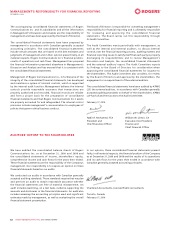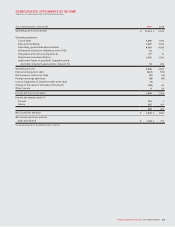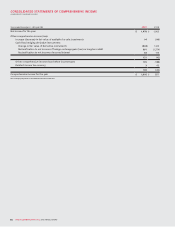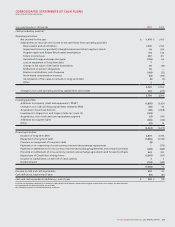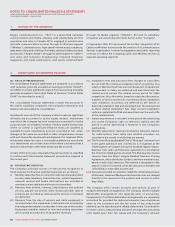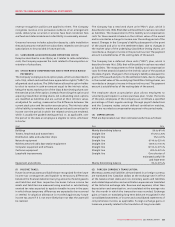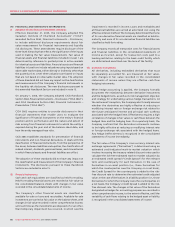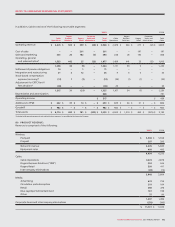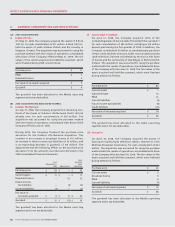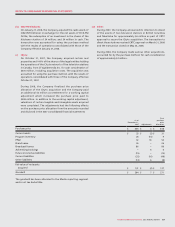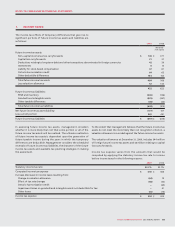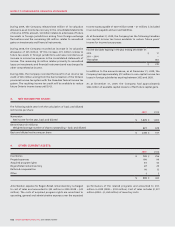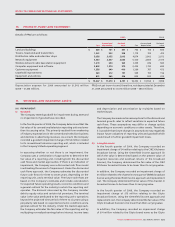Rogers 2009 Annual Report Download - page 88
Download and view the complete annual report
Please find page 88 of the 2009 Rogers annual report below. You can navigate through the pages in the report by either clicking on the pages listed below, or by using the keyword search tool below to find specific information within the annual report.
92 ROGERS COMMUNICATIONS INC. 2009 ANNUAL REPORT
NOTES TO CONSOLIDATED FINANCIAL STATEMENTS
manner as the value of goodwill is determined in a business
combination, is compared with its carrying amount to measure
the amount of the impairment loss, if any.
(iii) Intangible assets:
Intangible assets acquired in a business combination are
recorded at their fair values. Intangible assets with finite
useful lives are amortized over their estimated useful lives and
are tested for impairment, as described in note 2(q). Intangible
assets having an indefinite life, being spectrum and broadcast
licences, are not amortized but are tested for impairment on
an annual or more frequent basis by comparing their fair value
to their carrying amount. An impairment loss on an indefinite
life intangible asset is recognized when the carrying amount
of the asset exceeds its fair value.
Intangible assets with finite useful lives are amortized on a
straight-line basis over their estimated useful lives as follows:
Brand name – Rogers 20 years
Brand name – Fido 5 years
Brand name – Citytv 5 years
Subscriber bases 2¼ to 4²⁄ ³ years
Roaming agreements 12 years
Dealer networks 4 years
Marketing agreement 5 years
The Company tested goodwill and intangible assets with indefinite
lives for impairment during 2009 and recorded a write-down in
intangible assets of $5 million related to the CIKZ Kitchener and
OMNI broadcast licences (note 11(a)). The Company tested goodwill
and intangible assets with indefinite lives for impairment during
2008 and recorded a write-down of $154 million related to the
goodwill of the conventional television reporting unit and $75
million related to the Citytv broadcast licence (note 11(a)).
(Q) IMPAIRMENT OF LONG-LIVED ASSETS:
The Company reviews long-lived assets, which include PP&E and
intangible assets with finite useful lives, for impairment annually
or more frequently if events or changes in circumstances indicate
that the carrying amount may not be recoverable. If the sum of
the undiscounted future cash flows expected to result from the
use and eventual disposition of a group of assets is less than its
carrying amount, it is considered to be impaired. An impairment
loss is measured as the amount by which the carrying amount of
the group of assets exceeds its fair value.
The Company tested long-lived assets with finite useful lives
for impairment during 2009 and recorded a write-down of $13
million related to the OMNI Canadian Radio-television and
Telecommunication Commission (“CRTC”) commitments asset (note
13). The Company tested long-lived assets with finite useful lives for
impairment during 2008 and recorded a write-down of $51 million
related to the Citytv CRTC commitments asset (note 13) and $14
million related to the Citytv brand name (note 11(a)(ii)).
(R) ASSET RETIREMENT OBLIGATIONS:
Asset retirement obligations are legal obligations associated with
the retirement of PP&E that result from their acquisition, lease,
construction, development or normal operations. The Company
records the estimated fair value of a liability for an asset retirement
obligation in the year in which it is incurred and when a reasonable
estimate of fair value can be made. The fair value of a liability for
an asset retirement obligation is the amount at which that liability
could be settled in a current transaction between willing parties,
that is, other than in a forced or liquidation transaction and, in the
absence of observable market transactions, is determined as the
present value of expected cash flows. The Company subsequently
allocates the asset retirement cost to expense using a systematic
and rational method over the asset’s useful life, and records the
accretion of the liability as a charge to operating expenses.
(S) USE OF ESTIMATES:
The preparation of financial statements requires management to
make estimates and assumptions that affect the reported amounts
of assets and liabilities and disclosure of contingent assets and
liabilities at the date of the financial statements and the reported
amounts of revenue and expenses during the years. Actual results
could differ from those estimates.
Key areas of estimation, where management has made difficult,
complex or subjective judgments, often as a result of matters
that are inherently uncertain, include the allowance for doubtful
accounts and certain accrued liabilities, the ability to use income
tax loss carryforwards and other future income tax assets and
liabilities, capitalization of internal labour and overhead, useful
lives of depreciable assets and intangible assets with finite useful
lives, discount rates and expected returns on plan assets affecting
pension expense and the deferred pension asset, estimation of
Credit Spreads for determination of the fair value of derivative
instruments and the assessment of the recoverability or impairment
of long-lived assets, goodwill and intangible assets, which require
estimates of future cash flows and discount rates. For business
combinations, key areas of estimation and judgment include the
allocation of the purchase price and related severance costs.
Significant changes in the assumptions, including those with respect
to future business plans and cash flows, could materially change the
recorded carrying amounts.
(T) RECENT CANADIAN ACCOUNTING PRONOUNCEMENTS:
(i) Business Combinations:
In October 2008, the CICA issued Handbook Section 1582,
Business Combinations (“CICA 1582”), concurrently with
Handbook Sections 1601, Consolidated Financial Statements
(“CICA 1601”), and 1602, Non-controlling Interests (“CICA 1602”).
CICA 1582, which replaces Handbook Section 1581, Business
Combinations, establishes standards for the measurement of
a business combination and the recognition and measurement
of assets acquired and liabilities assumed. CICA 1601, which
replaces Handbook Section 1600, carries forward the


